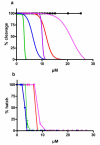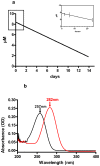Teratogenic effects of diatom metabolites on sea urchin Paracentrotus lividus embryos
- PMID: 20479962
- PMCID: PMC2866470
- DOI: 10.3390/md8040950
Teratogenic effects of diatom metabolites on sea urchin Paracentrotus lividus embryos
Abstract
The diatom-derived polyunsaturated aldehydes (PUAs), 2-trans,4-trans-decadienal, 2-trans,4-trans-octadienal, 2-trans,4-trans,7-octatrienal, 2-trans,4-trans-heptadienal, as well as tridecanal were tested on early and later larval development in the sea urchin Paracentrotus lividus. We also tested the effect of some of the more abundant diatom polyunsaturated fatty acids (PUFAs) on development, in particular 5,8,11,14,17-eicosapentaenoic acid (EPA), one of the main precursors of diatom PUAs, as well as 4,7,10,13,16,19-docosahexaenoic acid (DHA), 6,9,12,15-octadecatetraenoic acid (stearidonic acid), 6,9,12-octadecatrienoic acid (gamma-linolenic acid) and 9,12-octadecadienoic acid (linoleic acid). PUAs blocked sea urchin cell cleavage in a dose dependent manner and with increasing chain length from C7 to C10 PUAs, with arrest occurring at 27.27 microM with heptadienal, 16.13 microM with octadienal, 11.47 microM with octatrienal and 5.26 microM with decadienal. Of the PUFAs tested, only EPA and stearidonic acid blocked cleavage, but at much higher concentrations compared to PUAs (331 microM for EPA and 181 microM for stearidonic acid). Sub-lethal concentrations of decadienal (1.32-5.26 microM) delayed development of embryos and larvae which showed various degrees of malformations depending on the concentrations tested. Sub-lethal concentrations also increased the proportion of TUNEL-positive cells indicating imminent death in embryos and larvae. Using decadienal as a model PUA, we show that this aldehyde can be detected spectrophotometrically for up to 14 days in f/2 medium.
Keywords: TUNEL; apoptosis; development arrest; diatom; fatty acids; oxylipins; sea urchin; teratogens.
Figures


 ), aldehyde mix (see text) (
), aldehyde mix (see text) ( ), 2-trans,4-trans-octadienal (
), 2-trans,4-trans-octadienal ( ), 2-trans,4-trans,7-octatrienal (
), 2-trans,4-trans,7-octatrienal ( ), 2-trans,4-trans-heptadienal (
), 2-trans,4-trans-heptadienal ( ) and tridecanal (▪). Values (means ± S.D.; N = 600) are the results of three different experiments.
) and tridecanal (▪). Values (means ± S.D.; N = 600) are the results of three different experiments.
 ), EPA-ME (
), EPA-ME ( ), DHA (
), DHA ( ), stearidonic (
), stearidonic ( ), linoleic (▾) and γ-linolenic (
), linoleic (▾) and γ-linolenic ( ) acids. Values (means ± S.D.; N = 600) are the results of three different experiments.
) acids. Values (means ± S.D.; N = 600) are the results of three different experiments.




Similar articles
-
Molecular response to toxic diatom-derived aldehydes in the sea urchin Paracentrotus lividus.Mar Drugs. 2014 Apr 4;12(4):2089-113. doi: 10.3390/md12042089. Mar Drugs. 2014. PMID: 24714125 Free PMC article.
-
Toxicity of diatom-derived polyunsaturated aldehyde mixtures on sea urchin Paracentrotus lividus development.Sci Rep. 2019 Jan 24;9(1):517. doi: 10.1038/s41598-018-37546-y. Sci Rep. 2019. PMID: 30679744 Free PMC article.
-
Diatom-derived oxylipins induce cell death in sea urchin embryos activating caspase-8 and caspase 3/7.Aquat Toxicol. 2016 Jul;176:128-40. doi: 10.1016/j.aquatox.2016.04.012. Epub 2016 Apr 22. Aquat Toxicol. 2016. PMID: 27130972
-
Toxigenic effects of diatoms on grazers, phytoplankton and other microbes: a review.Ecotoxicology. 2010 Mar;19(3):493-511. doi: 10.1007/s10646-009-0434-y. Ecotoxicology. 2010. PMID: 19924531 Review.
-
Autophagy as a defense strategy against stress: focus on Paracentrotus lividus sea urchin embryos exposed to cadmium.Cell Stress Chaperones. 2016 Jan;21(1):19-27. doi: 10.1007/s12192-015-0639-3. Epub 2015 Sep 11. Cell Stress Chaperones. 2016. PMID: 26362931 Free PMC article. Review.
Cited by
-
Types and Distribution of Bioactive Polyunsaturated Aldehydes in a Gradient from Mesotrophic to Oligotrophic Waters in the Alborán Sea (Western Mediterranean).Mar Drugs. 2020 Mar 12;18(3):159. doi: 10.3390/md18030159. Mar Drugs. 2020. PMID: 32178402 Free PMC article.
-
Nitric oxide mediates the stress response induced by diatom aldehydes in the sea urchin Paracentrotus lividus.PLoS One. 2011;6(10):e25980. doi: 10.1371/journal.pone.0025980. Epub 2011 Oct 11. PLoS One. 2011. PMID: 22022485 Free PMC article.
-
Diatom-derived polyunsaturated aldehydes activate cell death in human cancer cell lines but not normal cells.PLoS One. 2014 Jul 3;9(7):e101220. doi: 10.1371/journal.pone.0101220. eCollection 2014. PLoS One. 2014. PMID: 24992192 Free PMC article.
-
Multiple Roles of Diatom-Derived Oxylipins within Marine Environments and Their Potential Biotechnological Applications.Mar Drugs. 2020 Jun 30;18(7):342. doi: 10.3390/md18070342. Mar Drugs. 2020. PMID: 32629777 Free PMC article. Review.
-
Molecular and Morphological Toxicity of Diatom-Derived Hydroxyacid Mixtures to Sea Urchin Paracentrotus lividus Embryos.Mar Drugs. 2019 Mar 1;17(3):144. doi: 10.3390/md17030144. Mar Drugs. 2019. PMID: 30823630 Free PMC article.
References
-
- Falkowski PG. The role of phytoplankton photosynthesis in global biogeochemical cycles. Photosynth Res. 1994;39:235–258. - PubMed
-
- Nelson DM, Treguer P, Brzezinski MA, Leynaert A, Queguiner B. Production and dissolution of biogenic silica in the ocean-revised global estimates, comparison with regional data and relationship to biogenic sedimentation. Global Biogeochem Cycles. 1995;9:359–372.
-
- Miralto A, Barone G, Romano G, Poulet SA, Ianora A, Russo GL, Buttino I, Mazzarella G, Laabir M, Cabrini M, Giacobbe MG. The insidious effect of diatoms on copepod reproduction. Nature. 1999;402:173–176.
-
- d’Ippolito G, Tucci S, Cutignano A, Romano G, Cimino G, Miralto A, Fontana A. The role of complex lipids in the synthesis of bioactive aldehydes of the marine diatom Skeletonema costatum. Biochim Biophys Acta Mol Cell Biol Lipids. 2004;1686:100–107. - PubMed
-
- Fontana A, d’Ippolito G, Cutignano A, Miralto A, Ianora A, Romano G, Cimino G. Chemistry of oxylipin pathways in marine diatoms. Pure Appl Chem. 2007;79:481–490.
MeSH terms
Substances
LinkOut - more resources
Full Text Sources
Research Materials
Miscellaneous
